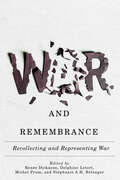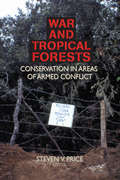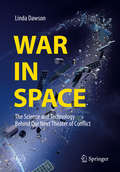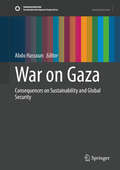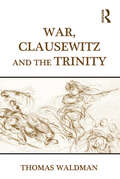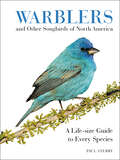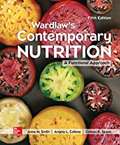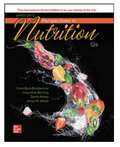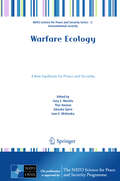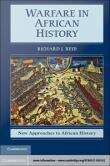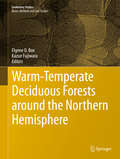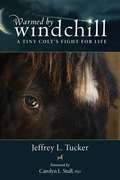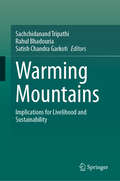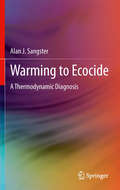- Table View
- List View
War and Health: The Medical Consequences of the Wars in Iraq and Afghanistan (Anthropologies of American Medicine: Culture, Power, and Practice #4)
by Catherine Lutz and Andrea MazzarinoProvides a detailed look at how war affects human life and health far beyond the battlefield Since 2010, a team of activists, social scientists, and physicians have monitored the lives lost as a result of the US wars in Iraq, Afghanistan, and Pakistan through an initiative called the Costs of War Project. Unlike most studies of war casualties, this research looks beyond lives lost in violence to consider those who have died as a result of illness, injuries, and malnutrition that would not have occurred had the war not taken place. Incredibly, the Cost of War Project has found that, of the more than 1,000,000 lives lost in the recent US wars, a minimum of 800,000 died not from violence, but from indirect causes. War and Health offers a critical examination of these indirect casualties, examining health outcomes on the battlefield and elsewhere—in hospitals, homes, and refugee camps—both during combat and in the years following, as communities struggle to live normal lives despite decimated social services, lack of access to medical care, ongoing illness and disability, malnutrition, loss of infrastructure, and increased substance abuse. The volume considers the effect of the war on both civilians and on US service members, in war zones—where healthcare systems have been destroyed by long-term conflict—and in the United States, where healthcare is highly developed. Ultimately, it draws much-needed attention to the far-reaching health consequences of the recent US wars, and argues that we cannot go to war—and remain at war—without understanding the catastrophic effect war has on the entire ecosystem of human health.
War and Moral Dissonance
by Peter A. FrenchThis collection of essays, inspired by the author's experience teaching ethics to Marine and Navy chaplains during the Iraq War, examines the moral and psychological dilemmas posed by war. The first section deals directly with Dr Peter A. French's teaching experience and the specific challenges posed by teaching applied and theoretical ethics to men and women wrestling with the immediate and personal moral conflicts occasioned by the dissonance of their duties as military officers with their religious convictions. The following chapters grew out of philosophical discussions with these chaplains regarding specific ethical issues surrounding the Iraq War, including the nature of moral evil, forgiveness, mercy, retributive punishment, honour, torture, responsibility and just war theory. This book represents a unique viewpoint on the philosophical problems of war, illuminating the devastating toll combat experiences take on both an individual's sense of identity and a society's professed moral code.
War and Remembrance: Recollecting and Representing War (Human Dimensions in Foreign Policy, Military Studies, and Security Studies)
by Renée Dickason, Delphine Letort, Michel Prum, and Stéphanie A.H. BélangerMemory, while seemingly a thing of the past, has much to reveal in the present. With its focus on memory, War and Remembrance provides new viewpoints in the field of war representation.Bringing an interdisciplinary approach to discussions of the cultural memory of war, the collection focuses on narratives, either fictional or testimonial, that challenge ideological discourses of war. The acts of remembrance and of waging war are constantly evolving. A range of case studies – analyzing representations of war in art, film, museums, and literature from Nigeria, Australia, Sri Lanka, Canada, and beyond – questions our current approaches to memory studies while offering reinterpretations of established narratives. Throughout, a commitment to Indigenous perspectives, to examining the ongoing legacy of colonialism, and to a continued reckoning with the Second World War foregrounds what is often forgotten in the writing of a single, official history.War and Remembrance invites readers to cast a reflexive look at wars and conflicts past – some of them forgotten, others still vividly commemorated – the better to understand the cultural, political, and social stake of memory as a source of conflict and exchange, of resistance and opposition, and of negotiation and reconciliation.
War and Technology: Society, Technology, And War From Ancient Times To The Present (Encounters: Explorations in Folklore and Ethnomusicology)
by Jeremy Black&“[A] scholarly overview of military technology throughout history—starting roughly in the 15th century and extending into the future . . . insightful.&”—Publishers Weekly In this engaging book, Jeremy Black argues that technology neither acts as an independent variable nor operates without major limitations. This includes its capacity to obtain end results, as technology&’s impact is far from simple and its pathways are by no means clear. After considering such key conceptual points, Black discusses important technological advances in weaponry and power projection from sailing warships to aircraft carriers, muskets to tanks, balloons to unmanned drones—in each case, taking into account what difference these advances made. He addresses not only firepower but also power projection and technologies of logistics, command, and control. Examining military technologies in their historical context and the present centered on the Revolution in Military Affairs and Military Transformation, Black then forecasts possible future trends. &“Clear, concise, and thoughtful. An eminently readable synthesis of historical literature on technology and war.&”—John France, author of Perilous Glory: The Rise of Western Military Power &“An interesting, thought provoking work by a major military historian . . . whose depth and wide range of knowledge across the entire sweep of world military history is without parallel.... Those who read this book closely will be richly rewarded for it is a mine of useful information and grist for discussion.&”—Spencer C. Tucker, author of The European Powers in the First World War &“A most useful introduction to a very complex subject, and particularly valuable for its notes and references to other works. Provocative and vigorously argued . . . Highly recommended.&”—Choice
War and Tropical Forests: Conservation in Areas of Armed Conflict
by Steven PriceExplore the conservation implications of recent armed conflicts in the tropical forest regions of Asia, Africa, and Latin America! From the lowland rainforests of the Colombian Amazon to the rugged habitat of Rwanda's mountain gorillas, civil, ethnic, and international wars have had severe impacts on tropical forests and the communities they sustain. The reemergence of war and the persistence of its impacts have led many conservationists to reassess their efforts and adapt their strategies to a new set of responsibilities and urgent challenges. War and Tropical Forests: Conservation in Areas of Armed Conflict explores these challenges and the lessons learned by conservationists working in conflict zones around the world. It combines case studies and comparative analyses by leading experts in ecological research, environmental policy, and conservation field programs to provide insight into the environmental dimensions of recent social, political, and humanitarian crises. War and Tropical Forests reviews lessons learned from conflict zones around the world and explores: the potential of conservation to reduce the frequency, duration, and impact of war preparation of conservation programs and local communities for crises strategies for maintaining conservation capacity during times of conflict the underlying political and economic factors that fuel war legal mechanisms for addressing wartime damage to tropical forests building partnerships amidst civil strife and political upheaval This essential book also examines: the Indonesian military's role in illegal logging and deforestation violent conflict and gorilla poaching in the Democratic Republic of Congo armed movements and forest conservation in Nicaragua's largest protected area and much more! War and Tropical Forests also addresses the role of militaries in the inequitable control and illicit use of forest resources, the environmental impact of refugees, the growing social and environmental costs of efforts to eradicate drug crops, and the impact of conflict on protected area management in the habitat of Africa's endangered great apes. War and Tropical Forests is an essential resource for conservation practitioners and policymakers, as well as anyone involved with human rights, conflict resolution, rural development, international law, or foreign relations.
War at the Speed of Light: Directed-Energy Weapons and the Future of Twenty-First-Century Warfare
by Louis A. Del MonteWar at the Speed of Light describes the revolutionary and ever-increasing role of directed-energy weapons (such as laser, microwave, electromagnetic pulse, and cyberspace weapons) in warfare. Louis A. Del Monte delineates the threat that such weapons pose to disrupting the doctrine of Mutually Assured Destruction, which has kept the major powers of the world from engaging in nuclear warfare. Potential U.S. adversaries, such as China and Russia, are developing hypersonic missiles and using swarming tactics as a means to defeat the U.S. military. In response, the U.S. Department of Defense established the 2018 National Security Strategy, emphasizing directed-energy weapons, which project devastation at the speed of light and are capable of destroying hypersonic missiles and enemy drones and missile swarms. Del Monte analyzes how modern warfare is changing in three fundamental ways: the pace of war is quickening, the rate at which weapons project devastation is reaching the speed of light, and cyberspace is now officially a battlefield. In this acceleration of combat called &“hyperwar,&” Del Monte shows how disturbingly close the world is to losing any deterrence to nuclear warfare.
War in Space: The Science and Technology Behind Our Next Theater of Conflict (Springer Praxis Books)
by Linda DawsonWith the recent influx of spaceflight and satellite launches, the region of outer space has become saturated with vital technology used for communication and surveillance and the functioning of business and government. But what would happen if these capabilities were disrupted or even destroyed? How would we react if faced with a full-scale blackout of satellite communications? What can and has happened following the destruction of a satellite? In the short term, the aftermath would send thousands of fragments orbiting Earth as space debris. In the longer term, the ramifications of such an event on Earth and in space would be alarming, to say the least. This book takes a look at such crippling scenarios and how countries around the world might respond in their wake. It describes the aggressive actions that nations could take and the technologies that could be leveraged to gain power and control over assets, as well as to initiate war in the theater of outer space. The ways that a country's vital capabilities could be disarmed in such a setting are investigated. In addition, the book discusses our past and present political climate, including which countries currently have these abilities and who the aggressive players already are. Finally, it addresses promising research and space technology that could be used to protect us from those interested in destroying the world's vital systems.
War of Nerves
by Jonathan B. TuckerStatesmen, generals, and diplomats have long debated the military utility and morality of chemical warfare. In 1925, the use of chemical weapons in war was prohibited by international treaty; in 1997 the ban on the use of chemical weapons was extended to cover their development, production, and stockpiling. Nevertheless, Iraq employed chemical weapons on a large scale as recently as the 1980s, first during its eight-year war with Iran and then against its rebellious Kurdish minority. InWar of Nerves, Jonathan Tucker, a leading expert on chemical and biological weapons, writes about chemical warfare from World War I to the present. The author makes clear how, at the turn of the twentieth century, the large-scale use of toxic chemicals on the battlefield became feasible and cheap; how Germany first developed and employed toxic weapons during World War I, burying some 6,000 cylinders (containing 168 tons of chlorine) opposite the Allied trenches defending the town of Ypres, in Belgium. German troops simultaneously opened the chlorine cylinders, panicking two French divisions and tearing a gap four miles wide in the Ypres front. Chemical warfare had begun: five months later, the Allies retaliated with their own use of chlorine gas. By the end of the war, chemical warfare had inflicted roughly one million casualties, 90,000 of them fatal. Tucker writes about the synthesis of the first nerve agent—Tabun—in 1936 by a German industrial chemist developing new pesticides how its high toxicity made it unusable as a pesticide but viable as a weapon for the Nazi regime. A few years later, two even more toxic nerve agents—Sarin and Soman—were developed for military use. Hitler never employed this secret weapon; German intelligence concluded—incorrectly—that the Allies had developed a similar capability. Following World War II, we see the rise of a Cold War chemical competition between the United States and the Soviet Union that paralleled the nuclear arms race, as each pursued the secrets of the German nerve agents; how the United States and Britain planned to mass-produce Sarin (only the United States did); how the superpowers developed and mass-produced V-agents, a new generation of nerve agents of extraordinary potency; and how nerve agents spread to the Third World, including their suspected use by Egypt during the Yemen Civil War (1963—1967), as well as Iraq’s use of nerve agents in its war against Iran and on its own people. Iraq’s use of nerve agents hastened the negotiation of an international treaty banning the use of chemical weapons, which went into effect in 1997. Although the treaty now has more than 175 member-states, al-Qaeda and related terrorist groups are seeking to acquire nerve agents. In this important and revelatory book, Jonathan Tucker makes clear that we are at a crossroads that could lead either to the further spread of these weapons or to their ultimate abolition. From the Hardcover edition.
War of the Worldviews: Where Science and Spirituality Meet -- and Do Not
by Deepak Chopra Leonard MlodinowTwo bestselling authors first met in a televised Caltech debate on “the future of God,” one an articulate advocate for spirituality, the other a prominent physicist. This remarkable book is the product of that serendipitous encounter and the contentious—but respectful—clash of worldviews that grew along with their friendship. InWar of the Worldviewsthese two great thinkers battle over the cosmos, evolution and life, the human brain, and God, probing the fundamental questions that define the human experience. How did the universe emerge? What is the nature of time? What is life? Did Darwin go wrong? What makes us human? What is the connection between mind and brain? Is God an illusion? This extraordinary book will fascinate millions of readers of science and spirituality alike, as well as anyone who has ever asked themselves, What does it mean that I am alive? From the Hardcover edition.
War on Gaza: Consequences on Sustainability and Global Security (Sustainable Development Goals Series)
by Abdo HassounThe relentless bombardment and blockade on Gaza have not only drastically restricted the inflow of essential food supplies but have also led to a catastrophic humanitarian crisis with unprecedented casualties. The widespread destruction has crippled the ability of the population to grow and process food, leaving Gazans without sufficient access to basic nutrition and pushing them to the brink of famine. Building on the previous work of Dr. Hassoun on acute food insecurity and malnutrition in Gaza, this book addresses not only Sustainable Development Goal (SDG) 2—Zero Hunger, SDG 3—Good Health and Well-being, and SDG 6—Clean Water and Sanitation, but all seventeen SDGs. While brief reports have been published on the topic, this will be the first in-depth scholarly work, offering case studies, data-driven analysis from various fields, and a comprehensive examination of the multidimensional and devastating impacts of war. With an urgent and multidisciplinary perspective, this book highlights the interconnectedness of war, sustainability, and global security, emphasizing how hostilities in Gaza have reversed progress toward achieving all SDGs, both in Gaza and beyond. Bringing together diverse expertise from 60 authors across 27 countries, the book showcases the international and interdisciplinary collaboration underlying its research. Through a series of carefully curated chapters written by specialists in various fields, it provides a comprehensive analysis of how war has affected societal structure, economic resilience, and environmental sustainability in Gaza. For each issue addressed, the text offers strategic insights and practical measures aimed at mitigating damage and fostering resilience. This book serves as a critical resource for policymakers, researchers, humanitarian organizations, and anyone who is interested in understanding and addressing the complex dynamics of conflict and sustainability.
War on Ivermectin: The Medicine that Saved Millions and Could Have Ended the Pandemic
by Pierre Kory Jenna McCarthyBig Pharma and health agencies cry, &“Don&’t take ivermectin!&” A media storm follows. Why then, does the science say the opposite?&” Ivermectin is a dirty word in the media. It doesn&’t work. It&’s a deadly horse dewormer. Prescribe or promote it and you&’ll be called a right-wing quack, be banned from social media, or lose your license to practice medicine. And yet, entire countries wiped out the virus with it, and more than ninety-five studies now show it to be unequivocally effective in preventing and treating Covid-19. If it didn&’t work, why was there a coordinated global campaign to cancel it? What&’s the truth about this decades-old, Nobel Prize-winning medication? The War on Ivermectin is the personal and professional narrative of Dr. Pierre Kory and his crusade to recommend a safe, inexpensive, generic medicine as the key to ending the pandemic. Written with Jenna McCarthy, Dr. Kory&’s story chronicles the personal attacks, professional setbacks, and nefarious efforts of the world&’s major health agencies and medical journals to dismiss and deny ivermectin&’s efficacy. Part personal narrative, part scathing expose, The War on Ivermectin highlights the catastrophic impacts of the mass media censorship and relentless propaganda that led to the greatest humanitarian crisis in history. Although numerous studies and epidemiologic data have shown that millions of lives were saved globally with the systematic use of ivermectin, many more millions perished. This carnage was the direct result of what Dr. Kory eventually discovered to be the pharmaceutical industry&’s silent but deadly war on generic medicines and the corrupt, captured medical and media systems that allow it to continue. For anyone who thought Covid-19 was the enemy, Dr. Kory&’s book will leave no doubt that the true adversary in this war is a collective cabal of power-hungry elites who put profits over people and will stop at nothing in their quest for control.The War on Ivermectin is published through ICAN PRESS, an imprint of Skyhorse Publishing. ICAN (Informed Consent Action Network) is a nonprofit organization investigating the safety of medical procedures, pharmaceutical drugs, and vaccines while advocating for people&’s right to informed consent.
War, Clausewitz and the Trinity
by Thomas WaldmanToday, the ideas of Carl von Clausewitz (1780-1831) are employed almost ubiquitously in strategic studies, military history and defence literatures, but often in a manner which distorts their true meaning. In this book, Waldman explores Clausewitz’s central theoretical device for understanding war - the ’remarkable trinity’ of politics, chance and passion. By situating the great Prussian in historical context, he presents a conception truer to Clausewitz’s intention. Seeking to achieve this through an in-depth reinterpretation of On War and Clausewitz’s other writings, conducted through the prism of the trinity, this book draws on existing studies but argues that there is room for clarification. It presents fresh perspectives into aspects of Clausewitz's thought and emphasises elements of his theory that have often been neglected. Furthermore, it provides a solid basis from which debate on the nature of modern war can move forward.
Warblers and Other Songbirds of North America: A Life-size Guide to Every Species
by Paul SterryA stunning full-color photographic field guide to 285 species in life-sized detail.Birds such as the Acadian Flycatcher, Golden-crowned Kinglet, Indigo Bunting, Northern Mockingbird, Pyrrhuloxia, Rock Wren, Song Sparrow, Tree Swallow, and the Yellow Throated Warbler are known for the elaborate songs produced by their highly developed vocal organs. Warblers and Other Songbirds of North America is a breathtaking collection of 285 species of these beautiful, melodious creatures, the largest number of species in a single field guide about North American songbirds.Arranged by region and taxonomic order, every songbird is depicted life-sized; each photograph is accompanied by a short description with essential information on identification and the particular species, habits, and behavior. Every species entry also includes a map showing where the species can be found, as well as a fact grid listing key details such as common and scientific name, length, food, habitat, status, and voice. You’ll also find fun facts about these members of the order Passeriformes—like how their toes allow them to perch with ease while they perform. Every photograph is gloriously detailed and chosen to show each species’ unique identification features and typical postures. Warblers and Other Songbirds of North America is ideal for the experienced birdwatcher, the aspiring naturalist, and every bird lover.
Wardlaw's Contemporary Nutrition: A Functional Approach
by Anne M. Smith Angela L. Collene Colleen SpeesContemporary Nutrition: A Functional Approach is an alternate version of Smith, Collene, Spees Contemporary Nutrition, offering a unique approach by organizing vitamins and minerals within the context of physiological functions and the health conditions they influence. Current research is at the core of the fifth edition, with revised statistics, incorporation of new results of clinical trials, and updated recommendations. The text provides students who lack a strong science background the ideal balance of reliable nutrition information and practical consumer-oriented knowledge. Always looking to make the content relevant to learners, the authors highlight health conditions, medications, food products, and supplements students or members of their families may be using. With their friendly writing style, the authors act as the student’s personal guide to dispelling common misconceptions and to gaining a solid foundation for making informed nutrition choices.
Wardlaw's Perspectives In Nutrition
by Carol Byrd-Bredbenner Gordon M. Wardlaw Jacqueline R. Berning Danita S. Kelley Jackie AbbotWardlaw’s Perspectives in Nutrition has the richly deserved reputation of providing an accurate, current, in-depth, and thoughtful introduction to the dynamic field of nutrition. The authors have endeavored to build upon this tradition of excellence by enriching this edition for both students and instructors. Their passion for nutrition, genuine desire to promote student learning, and their commitment to scientific accuracy, coupled with constructive comments from instructors and students, guided them in this revision.
Warehousing and Material Handling Systems for the Digital Industry: The New Challenges for the Digital Circular Economy
by Riccardo Manzini Riccardo AccorsiThis book illustrates innovative support-decision models, methods, and advanced automation and robotic technologies aimed at enhancing the overall performance of Warehousing and Material Handling (WMH) in terms of time and space efficiency, service levels, labor safety, and ergonomics. It provides a collection of cutting-edge issues commonly faced in warehousing systems worldwide, along with a structured set of methodologies and technological solutions to address them.Warehousing and Material Handling (WMH) are pivotal processes within supply chain and production systems. They involve the handling, consolidation, and storage of goods such as raw materials, parts, components, and finished products within distribution centers. WMH is also a key component of distribution networks, serving as a hierarchy of facilities dedicated to receiving materials from vendors and shipping to customers while meeting service level and performance targets.The book offers readers the opportunity to explore this topic from multiple knowledge levels and perspectives. At the basic level, it introduces readers to the problems, issues, nomenclature, fundamental models, and methods to support the decision-making process. At an intermediate level, it delves into the state-of-the-art on critical issues in warehousing and material handling systems. Finally, at an advanced level, it delves into the most challenging and recent research and industry issues, addressing both providers and users of WMH solutions and technologies.The book's intended audience includes undergraduate students, graduate students, PhD students, post-doc researchers, scholars, and researchers from academia and industry. It is also relevant for practitioners and managers working in production, logistics, and supply chain environments. The authors' approach is multidisciplinary, with a special focus on logistics, automation, optimization, safety, ergonomics, and the overall sustainability of WMH systems and operations.
Warfare Ecology
by Thor Hanson Gary E. Machlis Jean E. Mckendry Zdravko ŠpirićThe purpose of this book is specific and ambitious: to outline the distinctive elements, scope, and usefulness of a new and emerging field of applied ecology named warfare ecology. Based on a NATO Advanced Research Workshop held on the island of Vieques, Puerto Rico, the book provides both a theoretical overview of this new field and case studies that range from mercury contamination during World War I in Slovenia to the ecosystem impacts of the Palestinian occupation, and from the bombing of coral reefs of Vieques to biodiversity loss due to violent conflicts in Africa. Warfare Ecology also includes reprints of several classical papers that set the stage for the new synthesis described by the authors. Written for environmental scientists, military and humanitarian relief professionals, conservation managers, and graduate students in a wide range of fields, Warfare Ecology is a major step forward in understanding the relationship between war and ecological systems.
Warfare Since the Second World War
by Torsten SchwinghammerWarfare Since the Second World War presents a wealth of analysis and data about one of the most pressing questions of our time: why does war continue to plague us fifty years after World War II? This book argues that the nature of war has shifted from inter-state conflicts toward internal conflicts, above all civil war. Low-intensity conflict helps explain the constant increase in wars over the last fifty years and makes it probable this trend will continue. Gantzel and Schwinghammer argue that modern warfare reflects a continuation of the nation-state-building process begun in nineteenth-century Europe.In their analysis, economic modernization and social integration destroy traditional relations and create instability in the developing world. While these forces were successfully harnessed by the modern state in Europe and North America, economic and political globalization make a similar resolution considerably more complex. In addition to their insightful analysis, the authors provide a detailed list of all wars fought from 1945 to 1995. The authors' lucid explanatory commentaries are accompanied by lists, tables, and charts. In addition to a detailed war register, upon which all statistical data and analyses for the volume are based, there are appendices with directories useful for locating specific wars, as well as several supplementary lists. An afterword brings the reader closer to the world situation as we conclude the twentieth century; including the impact of political developments in Eastern Europe.Beyond its historical dimension, this book offers a policy-relevant empirical demonstration of the ongoing increase in internal (civil) wars and addresses the inability of modern society to prevent this scourge. Warfare Since the Second World War is an indispensable resource for anyone concerned with issues of war and peace, development, and the future of international relations.
Warfare in African History
by Richard J. ReidThis book examines the role of war in shaping the African state, society, and economy. Richard J. Reid helps students understand different patterns of military organization through Africa's history; the evolution of weaponry, tactics, and strategy; and the increasing prevalence of warfare and militarism in African political and economic systems. He traces shifts in the culture and practice of war from the first millennium into the era of the external slave trades, and then into the nineteenth century, when a military revolution unfolded across much of Africa. The repercussions of that revolution, as well as the impact of colonial rule, continue to this day. The frequency of coups d'états and civil war in Africa's recent past is interpreted in terms of the continent's deeper past.
Wargames
by Martin Van CreveldWhere did wargames come from? Who participated in them, and why? How is their development related to changes in real-life warfare? Which aspects of war did they capture, which ones did they leave out, how, and why? What do they tell us about the conduct of war in the times and places where they were played? How useful are they in training and preparation for war? Why are some so much more popular than others, and how do men and women differ in their interest? Starting with the combat of David versus Goliath, passing through the gladiatorial games, tournaments, trials by battle, duels, and boardgames such as chess, all the way to the latest simulations and computer games, this unique book traces the subject in all its splendid richness. As it does so, it provides new and occasionally surprising insights into human nature.
Warm-Temperate Deciduous Forests around the Northern Hemisphere
by Elgene O. Box Kazue FujiwaraWarm-temperate deciduous forests are "southern", mainly oak-dominated deciduous forests, as found over the warmer southern parts of the temperate deciduous forest regions of East Asia, Europe and eastern North America. Climatic analysis has shown that these forests extend from typical temperate climates to well into the warm-temperate zone, in areas where winters are a bit too cold for the 'zonal' evergreen broad-leaved forests normally expected in that climatic zone. This book is the first to recognize and describe these southern deciduous forests as an alternative to the evergreen forests of the warm-temperate zone. This warm-temperate zone will become more important under global warming, since it represents the contested transition between deciduous and evergreen forests and between tropical and temperate floristic elements. This book is dedicated to the memory of Tatsu Kira, the imaginative Japanese ecologist who first noticed and described this general zonation exception and who proposed the name warm-temperate deciduous forest.
Warmed by Windchill
by Jeffrey L. TuckerOne bitterly cold winter afternoon, a nine-month-old colt--extremely weak, starving, left to die--was frozen to the rock-hard white landscape of a northern Wisconsin pasture. His whinny for help barely carried through thirty-mile-an-hour winds lashing snow and ice against his thin coat. But somewhere inside him a light refused to go out. The colt's call for help was answered, and that light inspired a worldwide response to his story. The struggle of the little colt, called Windchill by his rescuers, was reported widely, and soon 1. 2 million people were following Windchill's progress on a blog and webcam. Warmed by Windchill tells how Jeffrey L. Tucker, owner of nearby Raindance Farms, and Kathi Davis, owner of a horse training operation co-located at Raindance, rescued and cared for the colt, aided by an outpouring of assistance. Donations of money, feed, blankets, and other supplies streamed in as round-the-clock volunteers tried to save Windchill. Warmed by Windchill is both heartening and heartbreaking.
Warming Mountains: Implications for Livelihood and Sustainability
by Satish Chandra Garkoti Rahul Bhadouria Sachchidanand TripathiThis contributed volume focuses on the sustainability of mountain ecosystems in the face of a changing climate. Its chapters highlight climate change impacts on the livelihoods of the people and communities that live in mountains and ways that these effects can be mitigated through adaptive measures. The chapters herein address a gamut of topics from use of remote sensing tools to assess changing ecosystems, disaster management in mountains, policymaking between institutions, and more. This book is suitable for students (undergraduate and postgraduates) of ecology and environmental studies/sciences, mountainous agriculture, mountain forestry, teachers, researchers, climate change scientists in academic and research institutions. It will also be useful to environmental management agencies particularly working towards sustainable development in mountainous regions, disaster management authorities, government agencies and policy makers.
Warming to Ecocide
by Alan J. SangsterDespite scientific evidence that business-as-usual is unsustainable, there is a huge and widespread inertia to 'greening' the planet. Warming to Ecocide considers climate change from a thermodynamic perspective and asks whether market-driven organisations have carried us to the point of no return through the flawed economics of endless growth. Warming to Ecocide begins by exploring the thermodynamic origins of climate change. It demonstrates that equilibrium thermodynamics can provide full explanations for the basic processes of life such as photosynthesis and metabolism, and that non-equilibrium thermodynamics is close to providing an explanation for how life started. Armed with a solid appreciation of the power of thermodynamics, the second half of Warming to Ecocide discusses whether multinational corporations have convinced the public that climate change is insignificant and thereby neutered any all attempts by governments to espouse environmentally-friendly policies. It then goes on to offer strategies whereby mankind may avoid propelling the global average temperature above the pre-industrial level by more than 2°C, which scientists view as a threshold presaging catastrophic run-away processes.


